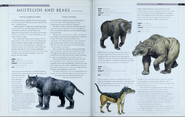| Hemicyon | |
|---|---|

| |
| Scientific classification |
Hemicyon, also known as the "dog-bear", is an extinct genus of hemicyonine bear, which probably originated in Eurasia but was found in Europe, Asia, and North America during the Miocene epoch, existing for approximately 16 to 13 mya.
Morphology[]
The morphology of Hemicyon can be described based on the known fossil remains of the genus. As a member of the family Amphicyonidae, Hemicyon shared certain characteristics with other bear dogs, but also exhibited its unique features. Here are some notable morphological aspects: Size: Hemicyon was a relatively large mammal, with different species varying in size. For example, Hemicyon giganteus is known to have been one of the largest bear dogs, estimated to have weighed around 350-400 kilograms (770-880 pounds). Body Shape: Hemicyon had a robust body structure resembling a bear. Its body was low-slung, with a strong skeletal frame. It had a long, muscular neck and a short, thick torso. Limbs: Hemicyon possessed sturdy limbs with strong claws. Its forelimbs were well-developed and likely adapted for grasping and holding onto prey. The hind limbs were also powerful, indicating an ability for running and agility. Dentition: Hemicyon had a specialized dentition adapted for a carnivorous diet. It had a combination of large, sharp canines and strong premolars and molars, suggesting it was a formidable predator. The teeth were adapted for tearing flesh and crushing bones. Skull: The skull of Hemicyon was relatively large and elongated. It had a well-developed sagittal crest, indicating strong jaw muscles. The snout was relatively short compared to some other bear dog species. Tail: Hemicyon had a long tail, which likely played a role in balancing its body during movement. The exact purpose and function of the tail are still subject to speculation.
Fossil sites[]
Fossil remains of Hemicyon have been discovered in various locations in Europe and North America. Here are a few notable fossil sites where Hemicyon fossils have been found: Hemicyon Fossil Sites in Europe: Sansan, France: The type species of Hemicyon, Hemicyon sansaniensis, was first discovered in Sansan, France. Numerous fossils of Hemicyon have been found in this region, providing valuable information about the genus. Steinheim am Albuch, Germany: Fossils of Hemicyon giganteus have been found in Steinheim am Albuch in Germany. This site has yielded well-preserved remains of various prehistoric mammals, including Hemicyon. Hemicyon Fossil Sites in North America: Nebraska, United States: Hemicyon fossils have been found in the Harrison Formation of Nebraska. These fossils contribute to our understanding of the ancient mammalian fauna in North America during the Oligocene epoch. Texas, United States: Fossil remains of Hemicyon have also been discovered in Texas, specifically in regions such as the Big Bend National Park. These findings add to the knowledge of the diversity and distribution of bear dogs in North America. California, United States: The Sespe Formation in California has yielded Hemicyon fossils, among other prehistoric mammals. These fossils provide insights into the ecosystems and biodiversity of the region during the Miocene epoch.



